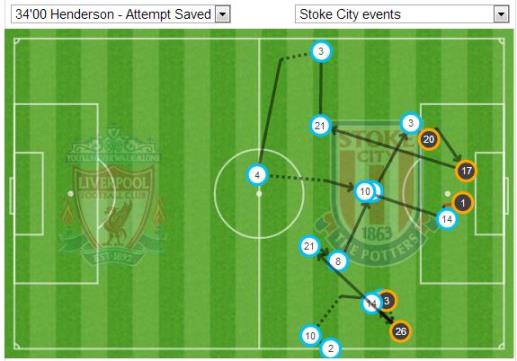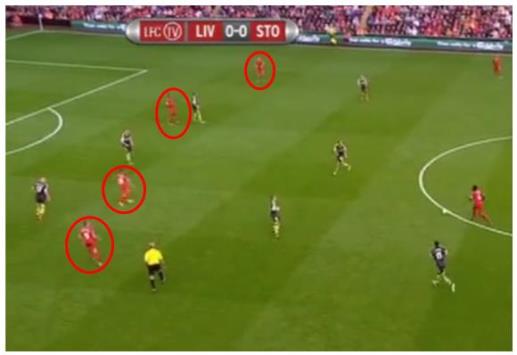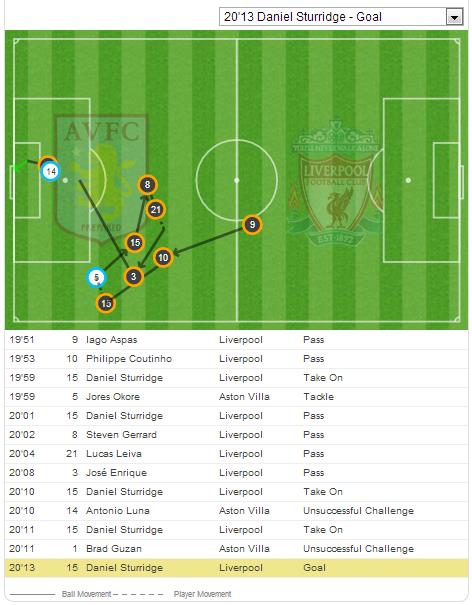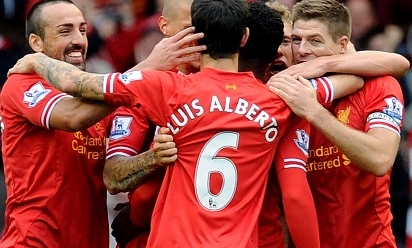Analysis: Meet 'The Interchangeables'
In his latest Talking Reds piece for Liverpoolfc.com, columnist Daniel Rhodes coins a new nickname to describe the impressive and effective movement in the Reds' front four…

Daniel Sturridge scored the winner, on his birthday, against Manchester United, to put us top of the Barclays Premier League, after three consecutive wins to start the season, for what feels like the first time in my living memory.
We have a new goalkeeper making match-winning saves and a defence keeping clean sheets. We have signed eight new players in this transfer window alone. So what shall I write about?
I know, attacking movement; Brendan Rodgers' decision to ignore the traditional, rigid, positional definitions in the front four positions, and instead help direct and produce 'The Interchangeables'.
Avoiding any further lame Pixar film references - although it is the best (made-up) word to describe Liverpool's' attacking players so far this season - I'll try, using the brilliant interactive Opta chalkboards (available on the official site a day or so after each match), to look at three individual examples of this fluid positional play.
The chalkboards not only illustrate the movement of the ball, but also that of the player; there is then a description below each incident, describing each part of the move. The dotted line signifies player movement, the bold lines the movement of the ball.
The first chalkboard, against Stoke at Anfield, covers 34 seconds of footage and finishes with a shot saved by Asmir Begovic from Jordan Henderson. In that time, Philippe Coutinho (10) is initially on the right flank with Henderson (14), the ball was then moved to the left; Jose Enrique (3) has a shot blocked, before the team retrieve the ball. Kolo Toure (4) finds Coutinho, who has now moved infield, picked up the ball in 'the hole' between the defensive and midfield lines, before spotting the diagonal run of Henderson, who has lost his marker.

The major advantage of having versatile players who can interchange is that it confuses the opposition defenders. The image below is just before Coutinho receives the ball from Toure.

Iago Aspas occupying the right-back, Coutinho drifting into the hole, Sturridge hanging on the shoulder of the deepest defender and you can see that Henderson has lost his man, Stoke's left-back, and is now waiting for the chance to make a run.
In this next image, you can see that Sturridge has moved deeper, Coutinho has picked up the ball, and Henderson is about to make his run. Sturridge's movement causes the opposition centre-back to step out slightly and make the through ball easier, Henderson sprints in-behind and Coutinho executes the through ball perfectly.

The next chalkboard highlights the build-up play before the Sturridge goal. Within this 60-second period, Sturridge positioned himself on the right hand corner of the area, before the team had to recycle, after another save from Begovic. Then, he moved infield to pick up a pass from Daniel Agger, before laying it off to Lucas Leiva, who found Aspas before the Spaniard laid it off to Sturridge.

The key factor in this move, apart from the sublime finish, was how Liverpool dragged the Stoke defensive unit about, even within a small area of the field. Sturridge, Aspas and Henderson were all on the right at one point in the build-up, and then in the middle a few seconds later. But, never at the same time. When Henderson was in the middle, for the earlier blocked shot from Sturridge, Aspas was in-between, before moving wide when the rebound deflected away. When Sturridge came deep, looking to receive the pass from Agger, Henderson moved wide right, on the edge of the penalty box; Aspas had drifted into the hole, looking to link up play with Lucas.
Each player must be tactically disciplined to make this approach successful. Henderson didn't touch the ball once during this passage of play, but he makes two or three decisive runs, he's always on the move and seemingly always aware of where he has to go if another attacking player moves into his zone.
The final example is from the match at Villa Park and covers the 20 seconds before Sturridge scored the winner.

This time Coutinho, Aspas and Steven Gerrard work hard to press the Aston Villa midfield, Aspas wins possession - in his own half - before feeding Coutinho on the left. Sturridge, at this point, picks the ball up tight to the left flank and tries to cut inside. He soon realises there is nothing on closer to goal and passes the ball backwards to Gerrard.
During these few seconds, Aspas and Coutinho (who were in their own half winning the ball back) have moved to the edge of the penalty box:

This time, Aspas moves left, Coutinho through the middle and Sturridge sprints into the gap between the centre-backs. Enrique crosses along the ground, Coutinho dummies and again Sturridge finishes with aplomb.
Nevertheless, without the movement, without the swapping of positions and without the patient build-up, the space would never materialise, the edge of the area would remain cramped and Villa's defence would find it a lot easier to stay compact, organised and in a straight line.
Conclusion
This is by no means the full list, detailing all the examples of interchanging movement. There were another eight, at least, that I could have used (just within the Opta data), and that does not include all of the occasions when we failed to create a chance from our intelligent movement.
The early part of the season certainly indicates a change in approach: a measured patient build-up, players fully aware of their restrictions, roles and their freedom to change positions accordingly. We look like a team. We have defended as a team, with somewhat different tactics to those we employed last year, as highlighted by Kate Cohen last week.
Furthermore, now we seem to be attacking as a team; with the front four available to run onto a pass, drop deep for the ball looking to feed one another with through balls, or finally interchange across the defensive line, causing havoc at times with the opposition's defensive organisation. More of the same, I say.
Follow the author @analysesport and read more of his work at tomkinstimes.com.




